
This is a placeholder text
Group text
by Pharaoh on 04 June 2010 - 18:06
I think this dog is about perfect, of course, I am slightly prejudiced.
Pharaoh's father, V-rated and KKL I, SchH III

Aron vom Poppitz
Michele
Pharaoh's father, V-rated and KKL I, SchH III

Aron vom Poppitz
Michele
by Red Sable on 04 June 2010 - 19:06
Very nice looking dog Michele, I agree.
Okay guys as for temperament, according to the standard, the GSD is to be aloof, and only become aggressive when threatened, or if necessary.
Why all the prey bite work than? Obviously the dog is going to be in defense when protecting. Should we have to teach it out of prey since a puppy? Why not just test the dog when fully mature, say 2 yrs old, on if he has what it takes to protect?
Can't any dog be taught to bite in prey on a field with the same routine and 'bad guy'? That to me doesn't show if a dog 'has it' or not. Did Max intend us to teach bite work the way we do? Honest question, I really don't know.
Okay guys as for temperament, according to the standard, the GSD is to be aloof, and only become aggressive when threatened, or if necessary.
Why all the prey bite work than? Obviously the dog is going to be in defense when protecting. Should we have to teach it out of prey since a puppy? Why not just test the dog when fully mature, say 2 yrs old, on if he has what it takes to protect?
Can't any dog be taught to bite in prey on a field with the same routine and 'bad guy'? That to me doesn't show if a dog 'has it' or not. Did Max intend us to teach bite work the way we do? Honest question, I really don't know.
by VomMarischal on 04 June 2010 - 19:06
Adi needs to answer that one.........or Slamdunc.........
by MaggieMae on 04 June 2010 - 19:06
stated by the "Expert" VM (LOL)
we just happen to believe that the show lines dogs' structure and movement is WRONG.
------------------------------------------
R.S. - you probably won't get an "honest answer" to your question or you may get an answer that will cause more confusion. I suggest following Max's standards and temperment description for his Breed -- not the Schutzhund Sports people's version.
by VomMarischal on 04 June 2010 - 20:06
Great answer, Maggie! Stick to the standard.
by Mystere on 04 June 2010 - 20:06
RS,
Some dogs, even worked in prey, demonstrate that they don't have "it." They will still go into avoidance. An example would be the dogs that refuse to engage the helper in the blind. That is hardly a heavy defense situation, but you often find dogs that cannot and will not go into the blind for a hold and bark. They circle the blind, stay behind the blind, crouch near the judge, etc. So, no, you cannot [teach] "any dog be taught to bite in prey on a field with the same routine and 'bad guy'." If that were the case, we would never see dogs refuse to engage the helper on their home training field with their home helper.
Puppies are always worked (properly) in prey. During that phase the puppy learns to grip fully, learns about countering, "fighting" the prey, rebites, making the helper react, etc. Those skills are part of the foundation training for the bitework.
I also want to address VM's comment. During one of the Cabajal conformation seminars I have attended (and I do highly recommend that everyone attend one, if you can) he established that the structure most amenable to success on the trial field is different than the conformation ideal. Specifically, the angulation that supplies the more explosive take-offs of working line dogs in the retrieves, courage test, send-out, escape, jumping etc. is NOT that desired for the ring. When asked why, then, the standard did not call for the structure more suited to the breed worthiness test, for the breed, he had no answer. So, VM, it would appear that you are correct and would have the corroboration by koermeisters, to a degree.
I also would mention that orthopedic and sports vets seem to be in agreement that the quest for the "good croup" (and consequent unstable pelvis) in the gsd is one of the reasons for such things as constricted rear leg muscles being seen exclusively in gsds
Some dogs, even worked in prey, demonstrate that they don't have "it." They will still go into avoidance. An example would be the dogs that refuse to engage the helper in the blind. That is hardly a heavy defense situation, but you often find dogs that cannot and will not go into the blind for a hold and bark. They circle the blind, stay behind the blind, crouch near the judge, etc. So, no, you cannot [teach] "any dog be taught to bite in prey on a field with the same routine and 'bad guy'." If that were the case, we would never see dogs refuse to engage the helper on their home training field with their home helper.

Puppies are always worked (properly) in prey. During that phase the puppy learns to grip fully, learns about countering, "fighting" the prey, rebites, making the helper react, etc. Those skills are part of the foundation training for the bitework.
I also want to address VM's comment. During one of the Cabajal conformation seminars I have attended (and I do highly recommend that everyone attend one, if you can) he established that the structure most amenable to success on the trial field is different than the conformation ideal. Specifically, the angulation that supplies the more explosive take-offs of working line dogs in the retrieves, courage test, send-out, escape, jumping etc. is NOT that desired for the ring. When asked why, then, the standard did not call for the structure more suited to the breed worthiness test, for the breed, he had no answer. So, VM, it would appear that you are correct and would have the corroboration by koermeisters, to a degree.
I also would mention that orthopedic and sports vets seem to be in agreement that the quest for the "good croup" (and consequent unstable pelvis) in the gsd is one of the reasons for such things as constricted rear leg muscles being seen exclusively in gsds
by Ninja181 on 04 June 2010 - 21:06
"R.S. - you probably won't get an "honest answer"
Well Maggs you were wrong she got a honest answer, probably because she asked in a civil manner without attacking people. Hint, Hint, Hint.
Well Maggs you were wrong she got a honest answer, probably because she asked in a civil manner without attacking people. Hint, Hint, Hint.
by Red Sable on 04 June 2010 - 21:06
Thank you Mystere for explaining, That makes sense :)
by oso on 04 June 2010 - 21:06
I agree with Mystere about the prey drive. Puppies that do not have it have to be taught in aggression, its the only way you can teach them to bite, and dogs taught in this way are never as secure as those with good prey drive and taught in prey initially.
I have also attended Ricardo Carvajal's seminar and I remember him saying something like that, but cannot quite remember the details now. However, I also have his videos and they explain very well why the angulations, relative bone lengths, croup length and position etc. are important for a dog that is meant to trot long distances without tiring (rather different from most of the work done in Schutzhund trials but very important in a herding dog).
Mystere please can you explain why a "good croup" leads to an unstable pelvis - I have not heard of this before?
VM, I am sure that a lot of WL breeders do select dogs taking into account their structure, but i think that many breeders also do not, and traditionally this has not been their emphasis. I do like the dog that Pharaoh posted, I would like a little better front angulation (that would allow a greater reach while trotting) and the under chest is a little short, but I think he has a pretty good structure overall, he is a strong impressive male with a nice head (I have seen plenty SLs not as good). I would be interested to know what features of SL structure that the SV judges like, you think are not correct to the standard?
I have also attended Ricardo Carvajal's seminar and I remember him saying something like that, but cannot quite remember the details now. However, I also have his videos and they explain very well why the angulations, relative bone lengths, croup length and position etc. are important for a dog that is meant to trot long distances without tiring (rather different from most of the work done in Schutzhund trials but very important in a herding dog).
Mystere please can you explain why a "good croup" leads to an unstable pelvis - I have not heard of this before?
VM, I am sure that a lot of WL breeders do select dogs taking into account their structure, but i think that many breeders also do not, and traditionally this has not been their emphasis. I do like the dog that Pharaoh posted, I would like a little better front angulation (that would allow a greater reach while trotting) and the under chest is a little short, but I think he has a pretty good structure overall, he is a strong impressive male with a nice head (I have seen plenty SLs not as good). I would be interested to know what features of SL structure that the SV judges like, you think are not correct to the standard?
by VomMarischal on 04 June 2010 - 21:06
Well, it seems to me that the standard, as illustrated in many drawings including the one on this board, does not include hock walking. I see an awful lot of that in German showlines nowadays....that and the "sloping topline." GSDs are supposed to be squares, not triangles.....but then, that's just how I see it.
Contact information Disclaimer Privacy Statement Copyright Information Terms of Service Cookie policy ↑ Back to top




